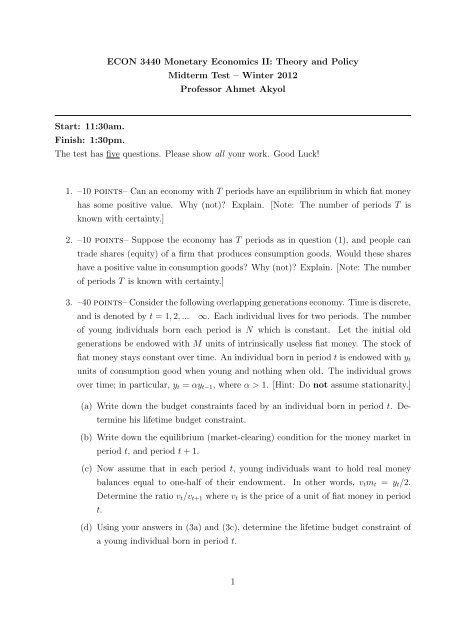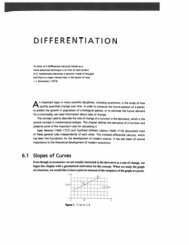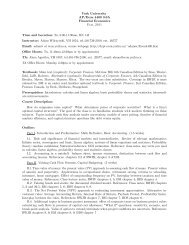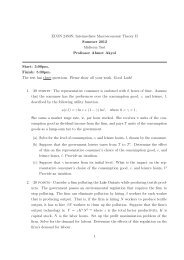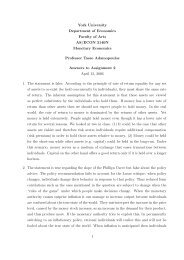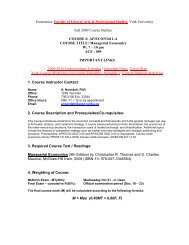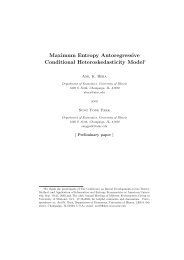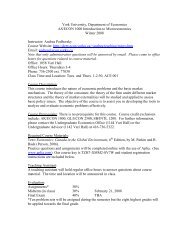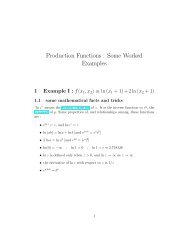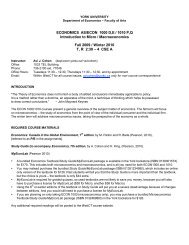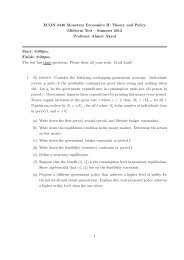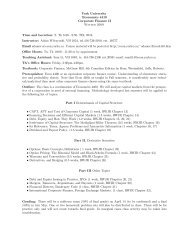ECON 3440 Monetary Economics II: Theory and Policy Midterm Test ...
ECON 3440 Monetary Economics II: Theory and Policy Midterm Test ...
ECON 3440 Monetary Economics II: Theory and Policy Midterm Test ...
- No tags were found...
You also want an ePaper? Increase the reach of your titles
YUMPU automatically turns print PDFs into web optimized ePapers that Google loves.
<strong>ECON</strong> <strong>3440</strong> <strong>Monetary</strong> <strong>Economics</strong> <strong>II</strong>: <strong>Theory</strong> <strong>and</strong> <strong>Policy</strong><strong>Midterm</strong> <strong>Test</strong> – Winter 2012Professor Ahmet AkyolStart: 11:30am.Finish: 1:30pm.The test has five questions. Please show all your work. Good Luck!1. –10 points– Can an economy with T periods have an equilibrium in which fiat moneyhas some positive value. Why (not)? Explain. [Note: The number of periods T isknown with certainty.]2. –10 points– Suppose the economy has T periods as in question (1), <strong>and</strong> people cantrade shares (equity) of a firm that produces consumption goods. Would these shareshave a positive value in consumption goods? Why (not)? Explain. [Note: The numberof periods T is known with certainty.]3. –40 points– Consider the following overlapping generations economy. Time is discrete,<strong>and</strong> is denoted by t = 1, 2, ...∞. Each individual lives for two periods. The numberof young individuals born each period is N which is constant.Let the initial oldgenerations be endowed with M units of intrinsically useless fiat money. The stock offiat money stays constant over time. An individual born in period t is endowed with y tunits of consumption good when young <strong>and</strong> nothing when old. The individual growsover time; in particular, y t = αy t−1 , where α > 1. [Hint: Do not assume stationarity.](a) Write down the budget constraints faced by an individual born in period t. Determinehis lifetime budget constraint.(b) Write down the equilibrium (market-clearing) condition for the money market inperiod t, <strong>and</strong> period t + 1.(c) Now assume that in each period t, young individuals want to hold real moneybalances equal to one-half of their endowment. In other words, v t m t = y t /2.Determine the ratio v t /v t+1 where v t is the price of a unit of fiat money in periodt.(d) Using your answers in (3a) <strong>and</strong> (3c), determine the lifetime budget constraint ofa young individual born in period t.1
4. –25 points– Consider an overlapping generations model with a commodity money(gold coins). There are 100 identical people in every generation. Each individualis endowed with 10 units of consumption good when young <strong>and</strong> nothing when old.Assume that each young individual wants to spend half of his endowment to purchasemoney balances, regardless of the return on money. The initial old generation owns atotal of 100 units of gold. Assume that individuals are indifferent between consumingone unit of gold <strong>and</strong> two units of the consumption good.(a) Suppose that gold is not consumed by the initial old generation. Write downthe money market equilibrium condition in a period t. Find the amount of goldpurchased by an individual, m g t , <strong>and</strong> the price of a gold coin, v g t .(b) Argue that gold is not consumed at this price of gold.(c) Suppose now that the economy has 800 units of gold. Calculate the price of gold.Would the initial old consume any gold? Does the price of gold change at thesame rate as the amount of gold in the economy?(d) Suppose that the government fights (<strong>and</strong> wins) a war <strong>and</strong> confiscates 100 units ofgold from the enemy in period t ∗ . The government uses these 100 gold coins topay for the cost of the war. Find the price of gold in period t ∗ − 1 <strong>and</strong> period t ∗ .Find the rate of return on gold purchased period t ∗ − 1.5. –15 points– Consider the following overlapping generations economy. Time is discrete,<strong>and</strong> is denoted by t = 1, 2, ... ∞. Each individual lives for two periods. In each period,each young individual has y units of consumption goods as an endowment while oldindividuals have no endowment. Indifference curves, which represent preferences ofindividuals, are negatively-sloped <strong>and</strong> convex. Population is constant. Assume thatthe history of individual’s actions are publicly observable.(a) Provide a social contract that replicates the allocation of a monetary equilibrium.(If you introduce a notation, you must define it.)(b) Are the transactions in this social contract constitute a debt? Explain.(c) Suppose now that the record-keeping technology is less than perfect such that afraction of the population finds it optimal to deviate from the social contract youprovided in (5a). Provide an alternative mechanism that improves the allocation.Explain.2


